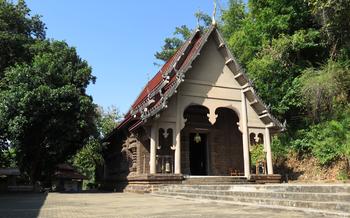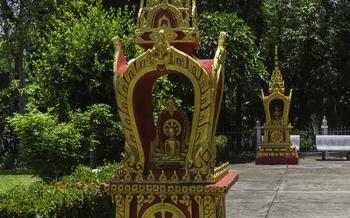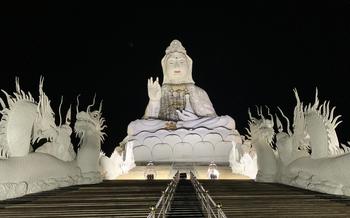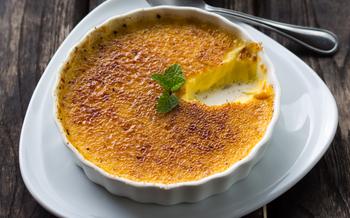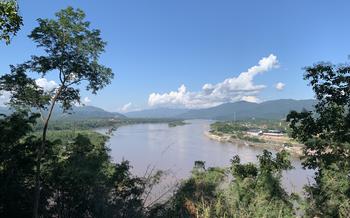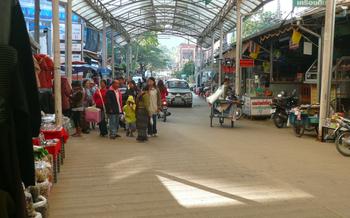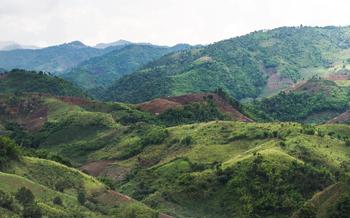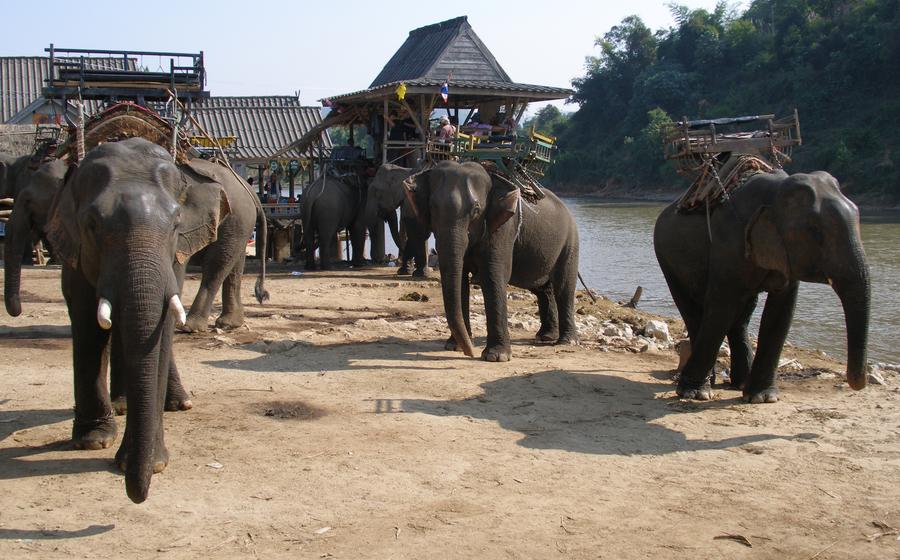
Doi Mae Salong Day Market
- Doi Mae Salong Day Market: A Cultural Tapestry on the Thai-Myanmar Border
- Exploring the Market Stalls
- Meeting the Hill Tribes
- Tasting Local Delicacies
- Shopping for Souvenirs
- Exploring the Surrounding Area
- The Best Time to Visit Doi Mae Salong Day Market
- Getting There
- Additional Tips for Visitors
- The Market's History
- The Local Culture
- The Market's Economic Impact
- The Future of the Market
- Personal Reflection
- Insider Tip: Uncover the Secret Tea Garden
Doi Mae Salong Day Market: A Cultural Tapestry on the Thai-Myanmar Border
Nestled amidst the verdant hills of northern Thailand, where the Thai-Myanmar border weaves its way through the landscape, lies the enchanting Doi Mae Salong Day Market. This vibrant marketplace pulsates with life, drawing visitors from far and wide to immerse themselves in its unique ambiance. The market's history is intertwined with the tumultuous events of the 20th century, as it emerged as a haven for Chinese Nationalist soldiers who fled to Thailand after the Chinese Civil War. Today, the market stands as a testament to their resilience and entrepreneurial spirit.
The market's strategic location on the border has fostered a diverse ethnic tapestry, with Akha, Lisu, and Yao hill tribes adding their vibrant threads to the cultural fabric. Each group brings its unique traditions, customs, and culinary delights, creating a kaleidoscope of sights, sounds, and flavors that captivate the senses. As you wander through the market's labyrinthine alleys, you'll be greeted by the warm smiles of the locals, eager to share their stories and showcase their wares.
Exploring the Market Stalls
Strolling through the vibrant alleys of Doi Mae Salong Day Market, you'll be greeted by a kaleidoscope of colors and aromas. The market is a treasure trove of local products and souvenirs, offering a glimpse into the rich cultural heritage of the region.
Fresh produce, harvested from the surrounding hills, forms the heart of the market. Vendors proudly display their wares, from plump tomatoes and crisp cucumbers to exotic fruits like dragonfruit and mangosteen. The air is filled with the sweet fragrance of ripe mangoes and the tangy scent of tamarind.
Alongside the produce, you'll find an array of handmade crafts that showcase the skill and artistry of the local hill tribes. Intricately woven textiles, adorned with vibrant patterns, hang from bamboo poles, while ceramic pottery and silver jewelry gleam in the sunlight.
There's a sense of authenticity and uniqueness to the items found here. You're not likely to find mass-produced souvenirs at Doi Mae Salong. Instead, each piece is lovingly crafted by local artisans, making it a one-of-a-kind keepsake.
During my own visit to the market, I was particularly drawn to the hand-embroidered cushion covers. The intricate designs and vibrant colors were unlike anything I'd seen before. I couldn't resist bringing a few home as a reminder of my time in Doi Mae Salong.
Meeting the Hill Tribes
Doi Mae Salong is home to a diverse array of hill tribes, each with its unique culture and traditions. The Akha, Lisu, Lahu, and Karen are among the most prominent tribes in the area. These ethnic groups have their own languages, customs, and ways of life, and interacting with them offers a glimpse into the rich cultural tapestry of Thailand.
As you stroll through the market, you'll have the chance to meet and chat with members of these hill tribes. They are generally friendly and welcoming, and they're happy to share their stories and experiences with visitors. You might learn about their traditional clothing, their agricultural practices, or their religious beliefs.
One of the highlights of visiting Doi Mae Salong is the opportunity to see the hill tribes in their traditional attire. The women often wear colorful skirts and blouses, while the men sport turbans and longyi (sarongs). You'll also find many stalls selling handmade crafts and souvenirs created by the hill tribes, providing a tangible reminder of their unique cultural heritage.
Tasting Local Delicacies
Prepare your taste buds for a culinary adventure at Doi Mae Salong Day Market. The air is filled with tantalizing aromas as vendors showcase their mouthwatering array of street food and local dishes.
Indulge in the flavors of Khao Soi, a hearty noodle soup featuring egg noodles in a rich coconut-based curry broth, topped with crispy fried noodles, pickled cabbage, and shallots. Savor the smoky and succulent Sai Oua, a northern Thai sausage made with minced pork, lemongrass, and kaffir lime leaves, grilled to perfection.
Don't miss the opportunity to try other local delicacies like Gaeng Hang Lay, a Burmese-style pork belly curry, or Khanom Jeen Nam Ngiao, rice noodles served with a spicy pork and tomato sauce. Each dish is a testament to the culinary heritage of the region, using fresh, local ingredients and traditional cooking methods.
As you stroll through the market, be sure to sample the variety of tropical fruits, including sweet mangoes, juicy pineapples, and refreshing dragon fruit. Quench your thirst with a glass of freshly squeezed sugarcane juice or indulge in a sweet treat like mango sticky rice or coconut ice cream.
Every bite at Doi Mae Salong Day Market is a journey of flavors that will leave you craving for more. So come hungry, embrace the culinary delights, and let your taste buds dance with joy.
Shopping for Souvenirs
Doi Mae Salong Day Market is a haven for souvenir hunters, offering a treasure trove of handmade crafts and unique items. From intricate textiles and ceramics to exquisite jewelry and home décor, there's something for every taste and budget.
Strolling through the market, you'll be amazed by the colorful displays of handwoven scarves, cushion covers, and traditional clothing. The textiles are often adorned with intricate embroidery and patterns inspired by the diverse ethnic groups of the region.
Another popular souvenir is ceramics, with a wide range of plates, bowls, vases, and figurines available. These ceramics are often handcrafted using traditional techniques and feature unique designs and glazes.
Jewelry lovers will delight in the selection of silver and gemstone jewelry, including necklaces, bracelets, earrings, and rings. Many of these pieces are handcrafted by local artisans using traditional designs and techniques.
For those looking to add a touch of local culture to their home décor, there are plenty of options to choose from. From hand-carved wooden sculptures to bamboo baskets and pottery, you're sure to find something that fits your style.
Remember, bargaining is a common practice at the market, so don't be afraid to haggle with the vendors. This is not only a way to get a better price but also a chance to interact with the locals and learn more about their culture.
By purchasing souvenirs from Doi Mae Salong Day Market, you're not only taking home a piece of Thailand but also supporting the local artisans and preserving their cultural heritage.
Exploring the Surrounding Area
Apart from the bustling market, Doi Mae Salong offers a wealth of attractions that beckon the curious traveler. Just a stone's throw away, nestled amidst the verdant hills, lies Wat Phra That Doi Mae Salong, a revered temple adorned with intricate murals and offering panoramic vistas of the surrounding countryside. For those seeking communion with nature, the cascading Mae Salong Waterfall beckons with its refreshing plunge pool, inviting visitors to bask in its cool embrace.
Venturing further afield, adventurous souls can embark on invigorating treks or leisurely hikes through the scenic mountains that encircle Doi Mae Salong. These trails wind past lush forests, cascading streams, and hidden waterfalls, offering a glimpse into the region's rich biodiversity. Along the way, trekkers may encounter friendly hill tribe villages, where they can learn about local customs and traditions and glimpse a way of life that has remained unchanged for centuries.
For a more immersive experience, consider venturing off the beaten path and visiting nearby villages such as Ban Pha Hee, renowned for its exquisite handmade paper, or Ban Loei, where visitors can witness the intricate process of tea cultivation. These charming villages offer a glimpse into the vibrant tapestry of local life, allowing travelers to connect with the warm and welcoming people who call this region home.
To make the most of your time in Doi Mae Salong, consider crafting a well-rounded itinerary that seamlessly blends market exploration with forays into the surrounding natural and cultural wonders. This approach will provide a holistic experience, ensuring that you delve deeply into the essence of this captivating destination.
The Best Time to Visit Doi Mae Salong Day Market
Doi Mae Salong Day Market operates year-round, offering a vibrant atmosphere and an abundance of local products regardless of the season. However, to enhance your experience, it's worth considering the best time of day and year to visit.
Best Time of Day
To avoid the midday heat and crowds, aim to arrive at the market early in the morning. This will give you ample time to explore the stalls, interact with the vendors, and capture stunning photos without battling the throngs of tourists. As the day progresses, the market becomes increasingly crowded, making it more challenging to navigate and enjoy the unique offerings.
Best Time of Year
The best time of year to visit Doi Mae Salong Day Market is during the cool season, which runs from November to February. During this period, the weather is pleasant, with cool breezes and comfortable temperatures, making it ideal for strolling through the market and exploring the surrounding area. Additionally, the dry season ensures that the roads are in good condition, making the journey from Chiang Rai more enjoyable.
Special Events and Festivals
Throughout the year, Doi Mae Salong Day Market hosts various special events and festivals that celebrate the local culture and traditions. These events showcase traditional dances, music, and cuisine, providing visitors with an immersive experience of the region's rich heritage. If you're fortunate enough to visit during one of these festivals, be sure to embrace the opportunity to participate in the festivities and connect with the local community.
Getting There
Reaching Doi Mae Salong Day Market from Chiang Rai is a breeze, with various transportation options to suit every traveler's needs and budget. Buses are the most economical choice, departing from Chiang Rai's main bus station and taking approximately three hours to reach the market. For a more comfortable journey, opt for a taxi or private tour, which offer direct service to the market and allow for customization of your itinerary. The approximate travel time by taxi or private tour is around two hours, and costs vary depending on the size of your group and the bargaining skills of your driver. Whichever mode of transport you choose, the scenic journey through the winding mountain roads offers breathtaking views of the surrounding countryside, making the trip an adventure in itself.
Additional Tips for Visitors
To make the most of your visit to Doi Mae Salong Day Market, here are a few additional tips:
-
Dress comfortably: The market is a vast area, and you'll be doing a lot of walking. Wear comfortable shoes and light clothing suitable for the weather.
-
Bring cash: Many vendors at the market may not accept credit cards, so it's important to bring cash for purchases.
-
Stay hydrated: The weather in Doi Mae Salong can be hot and humid, so make sure to stay hydrated by drinking plenty of water throughout your visit.
-
Be prepared for crowds: The market can get crowded, especially during weekends and holidays. If you prefer a more relaxed experience, consider visiting on a weekday or early in the morning.
-
Take your time: Don't rush your visit. Take some time to wander around the market, browse the stalls, and interact with the friendly locals. This is the best way to soak up the unique atmosphere and discover the hidden gems that the market has to offer.
The Market's History
Doi Mae Salong Day Market has a rich and fascinating history that dates back to the 1960s. It was originally established as a trading hub for the Chinese Nationalist Party (KMT), who fled to the area after the Chinese Civil War. The market served as a vital lifeline for the KMT, providing them with a source of food, supplies, and income. Over time, the market grew in size and popularity, attracting traders and shoppers from all over the region. In the 1990s, the market's reputation as a tourist destination began to grow, and it has since become one of the most popular attractions in Chiang Rai. Today, the market is a thriving hub of activity, where visitors can experience the unique blend of cultures and traditions that make Doi Mae Salong so special.
The Local Culture
Doi Mae Salong is home to a diverse array of ethnic groups, each with its unique customs and traditions. The Akha, Lisu, Lahu, and Chinese are among the most prominent hill tribes in the area. The Akha are known for their colorful textiles and elaborate headdresses, while the Lisu are skilled in silversmithing and bamboo weaving. The Lahu are renowned for their traditional dances and music, and the Chinese have brought their culinary expertise and cultural influences to the region.
Respecting local customs and etiquette is essential when visiting Doi Mae Salong. For example, it is considered polite to greet people with a "wai," a traditional Thai gesture involving placing your hands together in a prayer-like position. It is also important to dress modestly and avoid wearing revealing clothing, especially when visiting temples or religious sites.
Interacting with the locals is a fantastic way to learn about their culture and way of life. Many vendors at the market are happy to share stories about their traditions and customs. You can also visit local villages and attend cultural events to immerse yourself in the rich cultural heritage of the region.
The Market's Economic Impact
Doi Mae Salong Day Market plays a crucial role in supporting the local economy. It provides a platform for local entrepreneurs and artisans to showcase and sell their products, generating income and creating employment opportunities. The market attracts a large number of tourists, both domestic and international, who come to experience the unique atmosphere and purchase local goods. This influx of visitors contributes significantly to the local economy, as tourists spend money on food, accommodation, transportation, and souvenirs.
The market also helps to preserve and promote traditional crafts and cultural heritage. Many of the vendors sell handmade items that are produced using traditional methods and skills. By supporting these artisans, tourists help to keep these traditions alive and ensure that they are passed on to future generations.
Sustainable tourism practices are essential for ensuring the long-term viability of Doi Mae Salong Day Market. The market should be managed in a way that minimizes negative impacts on the environment and local community. This includes promoting responsible waste management practices, reducing plastic usage, and respecting local customs and traditions.
By embracing sustainability, the market can continue to benefit the community while preserving its unique character and charm for future generations.
The Future of the Market
Like many traditional markets in the face of globalization and the rise of modern shopping malls, Doi Mae Salong Day Market is not immune to challenges. The influx of tourists has brought both benefits and concerns. While tourism has boosted the local economy, it has also led to increased competition and the risk of losing the market's unique charm.
To ensure the market's long-term sustainability, several initiatives are underway. One focus is on promoting responsible tourism practices that respect the local culture and environment. Another is to support local artisans and entrepreneurs by providing training and market access. Additionally, efforts are being made to diversify the market's offerings and attract visitors throughout the year.
The future of Doi Mae Salong Day Market lies in striking a balance between preserving its authenticity and adapting to the changing needs of both locals and tourists. By embracing sustainable practices and fostering community involvement, the market can continue to thrive as a vibrant hub of cultural exchange, economic opportunity, and unforgettable experiences.
Personal Reflection
Doi Mae Salong Day Market is more than just a place to shop and eat; it's a place where cultures collide, and traditions are celebrated. The market's unique ambiance and the vibrant atmosphere created by the diverse ethnic groups left an unforgettable impression on me.
Interacting with the friendly locals and learning about their way of life was one of the highlights of my visit. The market provided a platform for cultural exchange, allowing me to gain a deeper understanding of the region's rich history and traditions.
Beyond the shopping and dining experiences, the market offered a glimpse into the daily lives of the people who call Doi Mae Salong home. Witnessing the interactions between the locals and the tourists, I was struck by the sense of community and camaraderie that permeated the air.
Doi Mae Salong Day Market is a testament to the power of cultural diversity and the importance of preserving local traditions. It's a place where visitors can not only find unique souvenirs and delicious food but also gain a deeper appreciation for the cultural heritage of the region.
Insider Tip: Uncover the Secret Tea Garden
Venture beyond the bustling market stalls and discover a hidden gem tucked away amidst the lush greenery – the Secret Tea Garden. This tranquil oasis, known only to locals and a few discerning travelers, offers a serene escape from the vibrant market atmosphere.
As you follow a narrow path, surrounded by towering trees and fragrant flowers, you'll stumble upon a picturesque tea plantation. Take a moment to admire the neatly arranged rows of tea bushes, basking in the warm sunlight. The air is filled with the delicate aroma of freshly picked tea leaves, creating a sense of tranquility and serenity.
At the heart of the tea garden, you'll find a charming teahouse where you can indulge in a traditional tea ceremony. Sip on a cup of freshly brewed tea, savoring its rich flavor and aroma while enjoying the breathtaking views of the surrounding landscape.
As you relax in the tranquility of the Secret Tea Garden, you'll have the opportunity to learn about the local tea-making process and the history of tea cultivation in the region. Take your time to explore the tea garden, soak in the peaceful ambiance, and let the worries of the world melt away.
Remember to bring your camera to capture the beauty of this hidden paradise. The Secret Tea Garden is a place that will stay in your memories long after your visit to Doi Mae Salong Day Market.


